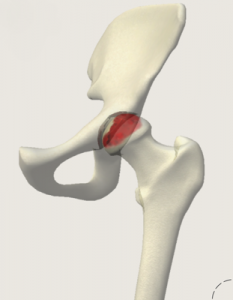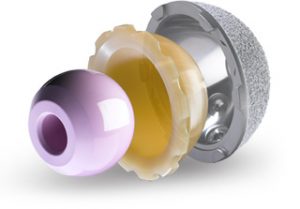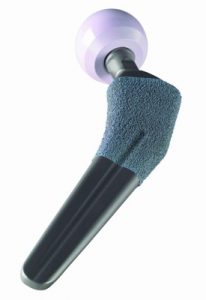
Diagram of a normal hip
Arthritis of the hip refers to damage to the smooth cartilage which normally lines the ball and socket joint of the hip. This can be caused by wear and tear, as a result of a previous injury, or can come on for no obvious reason. It sometimes runs in families. It typically affects people in their 60s and 70s, but not uncommonly affects younger adults. When the cartilage wears down to bare bone the condition becomes serious.
New research suggests that certain shapes of hip joint may be more likely to develop arthritis. In men ‘cam’ shaped hips where the ball is not perfectly round can contribute. In women pincer shaped hips, where the socket is too deep can cause problems. By the time you have developed hip arthritis this distinction is not very helpful!

Diagram of an arthritic hip
You will experience pain in the groin, which may radiate to the outside of the hip and down the thigh. To start with this is worse with activities, typically walking. You may also notice stiffness and reduced movement. bending down may become difficult, and putting on shoes may become hard work. It may be uncomfortable to sit for prolonged periods, and stiff when you first get moving again. The pain is typically a dull aching pain somewhat like a tooth ache. In the early stages it will respond well to anti-inflammatories or painkillers, but as the condition progresses these become less effective.
Pain in the buttock is often assumed to be hip arthritis, but this is more commonly caused by problems with the lower spine. Sometimes it can be quite difficult to distinguish between the two. X-ray, scans or injections may be used to ensure the correct diagnosis.

An uncemented socket with a ceramic on plastic bearing
In the early stages of arthritis painkillers, physiotherapy, and walking aids such as sticks can be helpful. As the condition progresses injections can be useful but these have to be administered in the operating theatre under a quick anaesthetic.
With time this will affect your mobility, and you’re walking distances. It will impact on your lifestyle, and impair quality of life. It may become painful at night-time and keep you awake at night or wake you up from sleep. When the symptoms reach this level it is time to consider having surgery in the form of a hip replacement.

Diagram showing a hip replacement in position
The hip replacements that we use today are very sophisticated pieces of metal and plastic or ceramic. The technology used is improving all the time, and this is generally a very successful, long lasting procedure. Hip replacements do still have a finite lifespan, but there are a variety of options for very long lasting hips. Recently an alternative to hip replacement called hip resurfacing became popular. This has recently fallen out of favour due to problems with metal on metal bearings. Dr. Amit does not use metal on metal hips.
If done well, by an experienced surgeon, then hip replacement has very high success rates and is long lasting. There are a number of choices to make about your surgery, and your implant which will depend on your personal details. Hip replacements can be cemented, or un-cemented and the moving parts may be made of metal, plastic, or ceramic, in a variety of combinations. Dr. Amit will discuss this with you prior to your surgery.

An uncemented ceramic hip
If you think you have hip arthritis it is well worth getting it checked out by Dr. Amit sooner rather than later. He has considerable experience in all techniques regarding hip arthritis and offers the very latest techniques in hip replacement surgery.
